Any opinions expressed in this article are the personal opinions of the author and should not form the basis for investment decisions, nor should they be considered a recommendation or advice to engage in investment transactions.
I went the opposite direction and ended my summer vacation by heading to the Southern Hemisphere for two weeks of skiing. I spend most of my time backcountry skiing and mountaineering...a typical four to five hour ski day consists of 80% uphill skiing and 20% downhill skiing.
Therefore, this activity is very energy intensive and your body will burn a lot of calories to maintain homeostasis in the body. The legs, the largest muscle group in the body, are constantly working whether you are climbing or downhill skiing. My basal metabolic rate is close to 3000 kcal; plus the energy required to fuel my legs, my total daily consumption is over 4000 kcal.
Because of the incredible amount of energy required to complete this activity, it's especially important what I eat throughout the day. I eat a breakfast full of carbs, meats, and vegetables in the morning; I call it "real food." Breakfast left me feeling full, but this initial energy reserve was quickly depleted as we entered the cold forest and began the first climb.
To manage my blood sugar levels, I carry snacks that I would normally avoid, just as ZhuSu and Kyle avoided the liquidator appointed by the British Virgin Islands Bankruptcy Court. I eat Snickers or candy on average every 30 minutes, even when I'm not hungry. I don't want my blood sugar levels to drop and affect my performance.
Eating sugary processed foods was not the solution to my long-term energy needs. I need to eat "real food" too. Every time I complete a lap, I usually stop for a few minutes, open my backpack, and eat the "meal" I prepared. I prefer a Tupperware container filled with chicken or beef, sautéed greens, and plenty of white rice.
I maintain my performance throughout the day by combining regular sugar supplements with longer-lasting, clean “real foods.”
The purpose of describing my ski mountaineering dietary preparation is to elicit a discussion about the relative importance of monetary price versus monetary quantity. To me, the price of currency is like the Snickers and candies I eat for a quick glucose boost, and the quantity of currency is like the slow-burning “real food.”
The U.S. Federal Reserve (Fed) finally committed to lowering its policy interest rate after Powell announced the policy shift at a meeting of central bankers in Jackson Hole on Friday. In addition, officials from the Bank of England (BOE) and the European Central Bank (ECB) also said they would continue to cut policy rates.
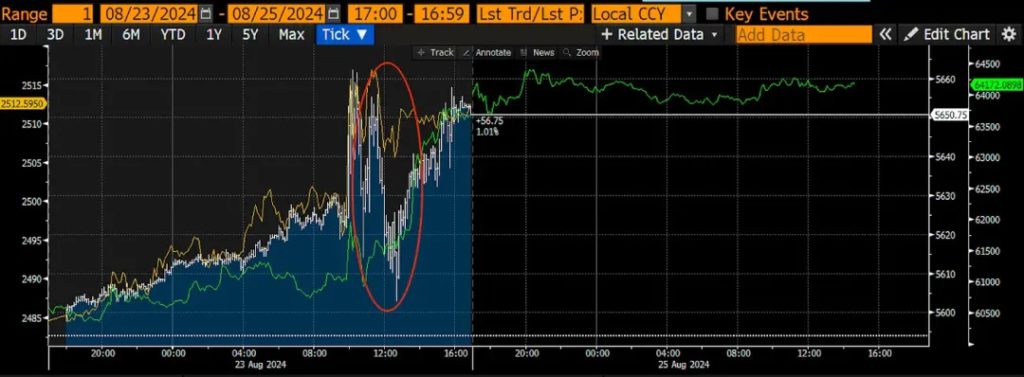
Ball announced the policy shift at approximately 9am GMT, which corresponds to the red oval in the chart. Risk assets such as the S&P 500 (white), gold (gold) and Bitcoin (green) all rose as currency prices fell. The U.S. dollar (not shown here) also weakened at the end of the week.
The initial positive reaction from the market is justified as investors believe that assets priced in fiat dollars should rise if the currency becomes cheaper. I agree; however... we are ignoring the fact that expected future interest rate cuts by the US Federal Reserve, Bank of England and European Central Bank will reduce the interest rate differentials between these currencies and the Japanese Yen.
The risk of the yen carry trade unraveling will re-emerge and could spoil the feast unless the "real food" comes in the form of central bank balance sheet expansion, i.e. money printing .
I will mention this phenomenon frequently in this article.
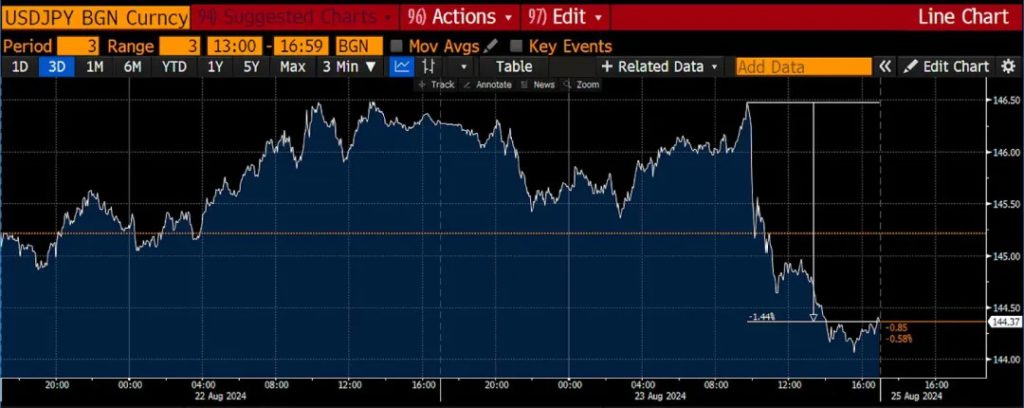
USD/JPY gained 1.44%, while USD/JPY fell immediately after Powell announced the policy shift. This is expected because as USD rates fall and JPY rates remain flat or rise, the forward spread for USD/JPY will narrow.
The remainder of this article is intended to reinforce this view and present my key outlook for the coming months, before American voters elect an Orange Man or Chameleon.
As we saw in August this year, a rapid appreciation of the yen is a disaster for global financial markets. If the world's three largest economies cut interest rates and cause the yen to appreciate against their own currencies, then we should expect a negative market reaction. We are in a confrontation between the positive forces of lower interest rates and the negative forces of a rising yen.
Given the trillions of dollars of global financial assets financed in yen, I believe the negative market reaction to the unraveling of the yen carry trade due to the rapid appreciation of the yen will be far greater than a small increase in the dollar, pound or euro. any benefit from a rate cut.
Furthermore, I believe that the wizards and wizards leading the US Federal Reserve, the Bank of England and the European Central Bank realize that they must be willing to ease policy and expand their balance sheets to counter the adverse effects of a rising yen.
Following my skiing analogy, the Fed is getting ready to enjoy the sugar rush of interest rate cuts before hunger sets in. From a purely economic perspective, the Federal Reserve should raise interest rates at this time rather than cut them.
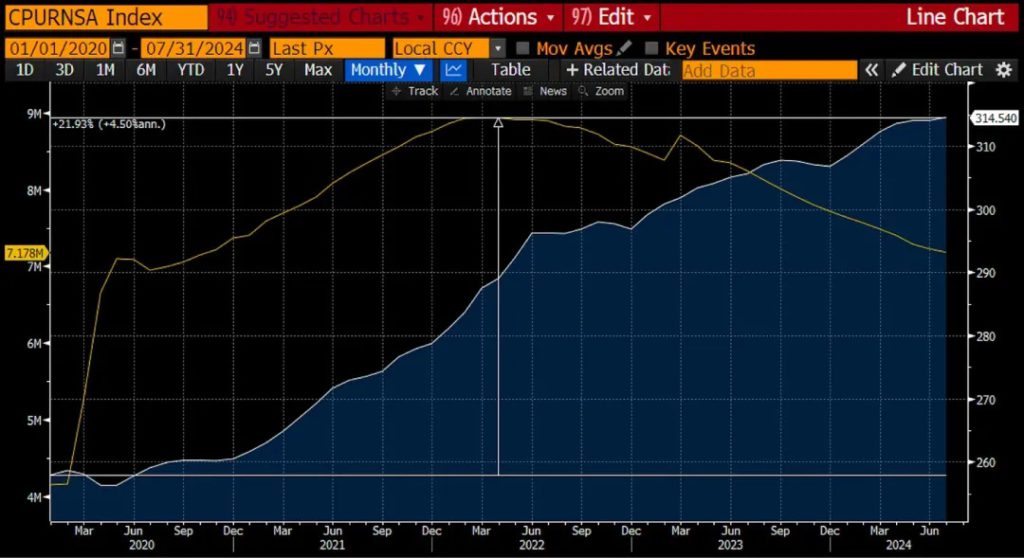
Since 2020, the U.S. Consumer Price Index (white) has increased 22%. The Fed's balance sheet (gold) increased by more than $3 trillion.
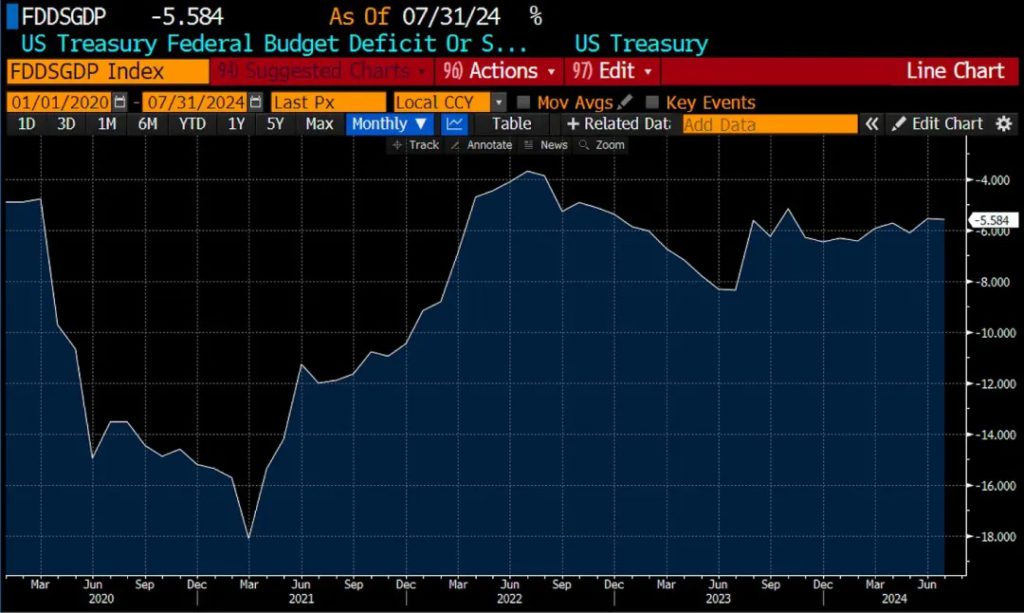
U.S. government deficits are at record highs, in part because the cost of issuing debt is not yet high enough to force politicians to raise taxes or cut benefits to balance the budget.
If the Federal Reserve really wants to maintain confidence in the dollar, it should raise interest rates to curb economic activity. This will lower prices for everyone, but some will lose their jobs. This will also rein in government borrowing as the cost of issuing debt will rise.
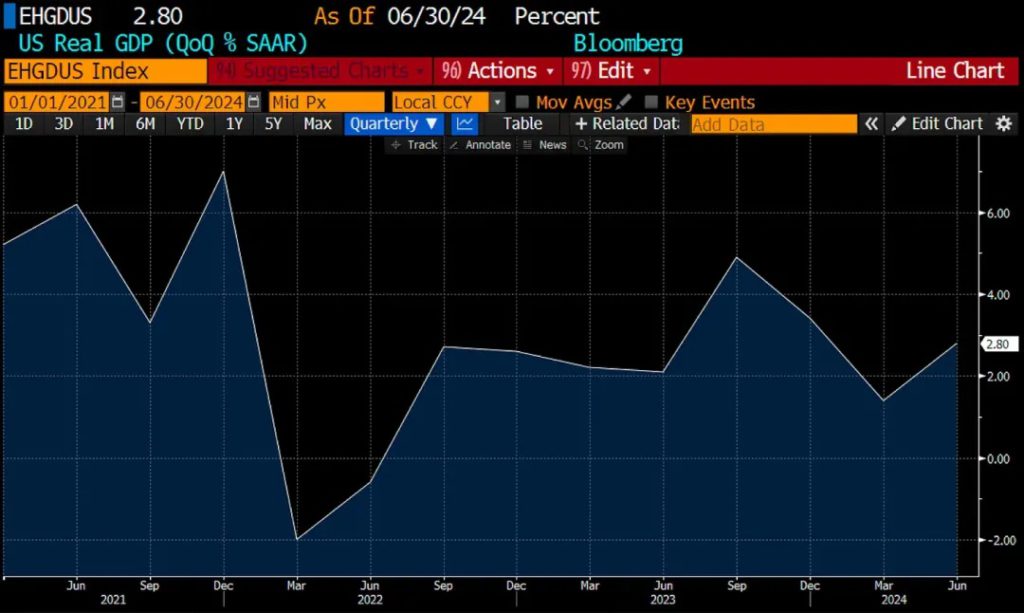
Post-COVID-19, the U.S. economy has experienced only two quarters of negative real GDP growth. This is not a weak economy that needs rate cuts.
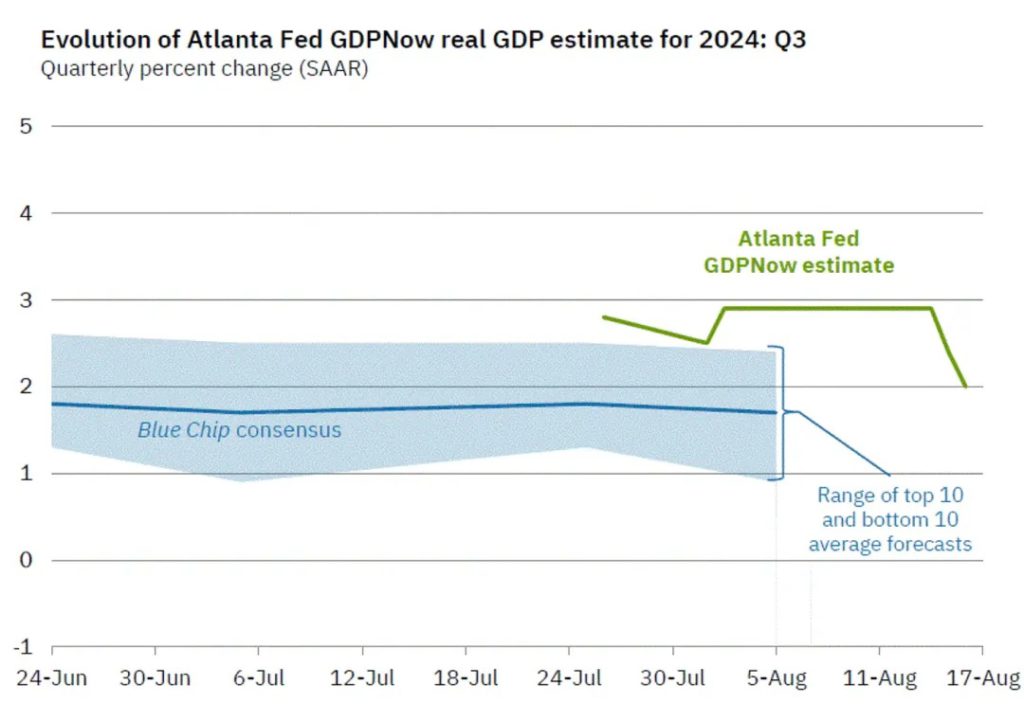
Even the latest estimate for Q3 2024 is a solid +2.0%. Again, this is not an economy trapped by too high interest rates.
Just like I eat candy and syrup when I'm not hungry to avoid a drop in my blood sugar levels, the Fed is determined to never let financial markets stop their upward trend. The United States is a highly financialized economy that needs fiat asset prices that only rise but never fall to make its people feel rich. Looking at real returns, stocks are either flat or down, but most people don't focus on real returns.
Capital gains tax revenue has also been boosted by gains in stocks denominated in fiat currencies. Simply put, falling markets are bad for the financial health of the American empire. Therefore, starting in September 2022, bad girl Yellen began to subvert the US Federal Reserve's interest rate hike cycle. I believe that Ball, at the direction of Yellen and Democratic leaders, is sacrificing himself and cutting interest rates even though he knows he shouldn't.
I show the chart below to illustrate that since the U.S. Treasury, under Yellen’s control, began issuing massive amounts of Treasury bills (T-bills) and funneling sanitized funds from the Fed’s reverse repurchase (RRP) program into the broader financial What happened to the stock market after the market.
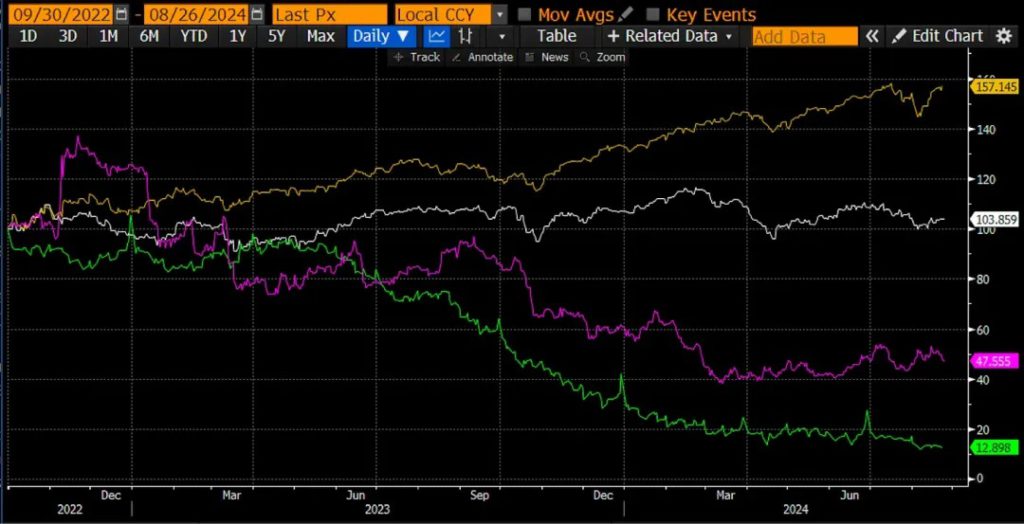
All prices are based on 100 on September 30, 2022; this was the peak RRP of approximately $2.5 trillion. RRP (green) dropped 87%. The S&P 500 Index (gold) saw a 57% rise in nominal U.S. dollar-denominated returns. I continue to declare that the Treasury Department is more powerful than the Federal Reserve.
The US Federal Reserve has been raising currency prices until March 2023, but the Treasury Department is also driving the market higher by increasing the money supply. The result is a rise in stock markets denominated in fiat currencies that are nominally booming. Measured against gold, the oldest real money (everything else is credit), the S&P 500 (white) is up just 4%. Measured against Bitcoin, the newest hard currency, the S&P 500 (magenta) is down 52%.
The U.S. economy does not need to cut interest rates, but Powell will still provide this "sugar stimulus." With monetary authorities overly sensitive to anything that might disrupt the ongoing rise in nominal fiat equity prices, Powell and Yellen will soon be providing "real food" to offset Japan's decline through some form of Fed balance sheet expansion. The impact of yuan appreciation.
Before discussing the appreciation of the yen, I want to quickly touch on the far-fetched rationale that Ball presented for a rate cut and how this further strengthens my confidence in riskier asset prices rising.
Ball's policy shift was based on a bad jobs report. Just days before Ball's speech in Jackson Hole, President Joe Biden's Bureau of Labor Statistics (BLS) released a shocking negative revision to previous employment data. They noted that previous employment estimates exceeded the estimate by about 800,000 positions.
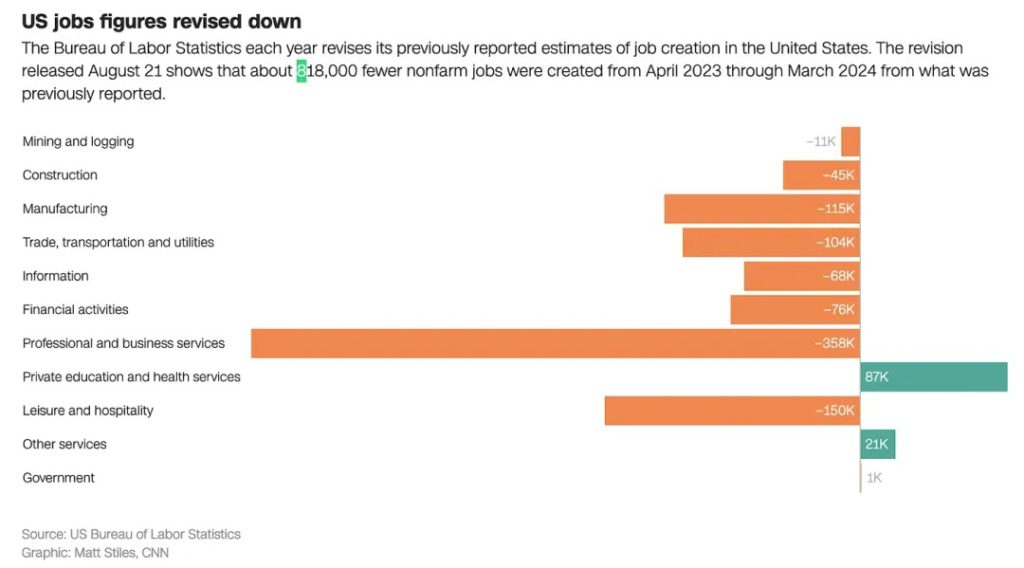
Biden and his crooked economist backers have been touting the strength of the labor market during his tenure. The strong performance puts Powell in an awkward position, as top Democratic senators like Elizabeth "Pocahontas" Warren call on him to cut interest rates and stimulate the economy to prevent the "evil orange man" Win the election.
Ball was in trouble. With inflation above the Fed's 2% target, Powell cannot cite falling inflation as a reason to cut interest rates. Nor can he cite a weak labor market as a reason to cut interest rates. But let’s sprinkle a little political misdirection magic on the situation and see if that helps our “low-level submissive” Ball out of trouble.
Biden was kicked out of the Obama family after appearing like a confused vegetable on prescription drugs during a debate with Trump. So enters the chameleon Harris Harris, who, if you believe the mainstream media propaganda, has nothing to do with any of the policies implemented by the Biden/Harris administration over the past four years.
Therefore, the Bureau of Labor Statistics (BLS) can admit their missteps without affecting Harris since she was not actually involved in the administration she served as vice president. Wow — what a piece of political magic.
Ball could have used labor market weakness to justify cutting interest rates, but he did not. Now that he has announced that the U.S. Federal Reserve will begin cutting interest rates in September, the only question is how deep the first cut will be.
I am more confident in my predictions when politics takes precedence over economics. This is because of Newtonian political physics – politicians in power want to stay in power.
They will do whatever is necessary to ensure re-election, regardless of economic conditions. This means that no matter what happens, the incumbent Democrats will use all monetary levers to ensure that stocks rise before the November election. The economy will not be short of cheap and abundant dirty fiat currency.
Yen destroying bomb
An important driver of exchange rates between currencies is interest rate differentials and expectations of future changes.
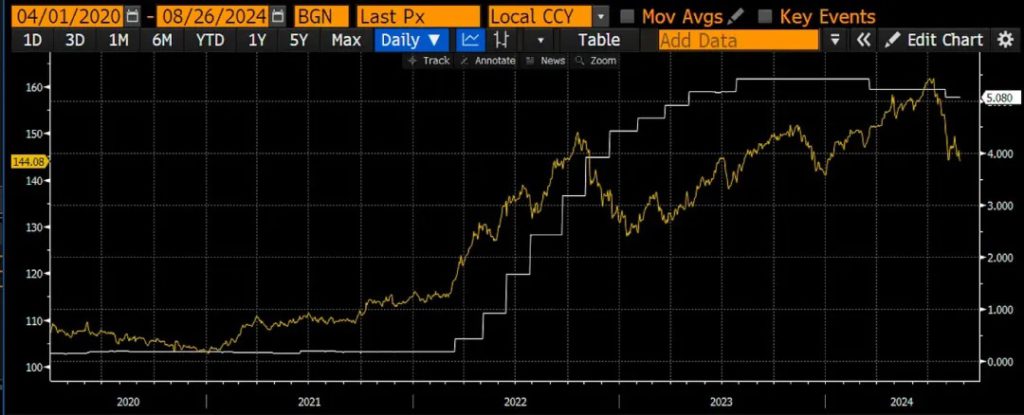
The chart above shows the relationship between the USD/JPY exchange rate (yellow) and the USD-JPY spread (white). The spread is the U.S. Federal Reserve's effective funds rate minus the Bank of Japan's overnight deposit rate.
When the U.S. dollar exchange rate rises against the Japanese yen, the Japanese yen depreciates and the U.S. dollar appreciates; when the exchange rate falls, the opposite is true. When the U.S. Federal Reserve began its interest rate hike cycle in March 2022, the yen depreciated sharply. In July this year, when the interest rate spread was close to its maximum, the depreciation of the yen reached its peak.
The yen appreciated sharply after the Bank of Japan raised its policy interest rate by 0.15% to 0.25% at the end of July. The Bank of Japan has made it clear that it will start raising interest rates at some point in the future, but the market is unclear when they will begin in earnest. Like an unstable snowpack, you never know which snowflake or skiing move will trigger an avalanche.
While a 0.15% spread tightening should be inconsequential, it is not. The avalanche of yen appreciation has begun, and now the market is highly concerned about the future path of the USD-JPY interest rate differential. As expected, the yen strengthened on expectations of further narrowing in interest rate differentials following Powell's policy shift.

This is a previous chart of the USD/JPY exchange rate. I would like to emphasize again that the yen appreciated a bit after Powell confirmed that a rate cut in September was on the cards.
If the value of the yen surges and traders resume unwinding their USD-JPY carry trade positions, the "sugar boost" from the Fed's interest rate cuts may be short-lived. More rate cuts to stem the decline in various financial markets would only accelerate the narrowing of USD-JPY spreads, which in turn would strengthen the JPY and lead to more positions being unwound.
The market needs the "real food" provided by the Fed's balance sheet expansion, namely money printing, to curb this situation.
If the yen appreciates at an accelerated pace, the first step is not to resume quantitative easing (QE) money printing. The first step would be for the Fed to reinvest the cash from maturing bonds in its portfolio into Treasuries and mortgage-backed securities. This will be announced as the end of its quantitative tightening (QT) program.
If the pain train continues, the Fed will resort to using central bank liquidity swaps or resuming QE's money-printing operations. Behind the scenes, bad girl Yellen will increase dollar liquidity by selling more Treasury bills (T-bills) and draining the Treasury General Account (TGA).
None of these market manipulators would cite the devastating impact of the unraveling of the yen carry trade as a reason to resume aggressive money printing. The United States is extremely reluctant to admit that any other country has any influence on this glorious empire of freedom and democracy!
If USD/JPY falls below 140 quickly, I believe they will not hesitate to provide the "real food" that dirty fiat financial markets thrive on.
Trading settings
Heading into the final stretch of Q3, fiat liquidity conditions couldn’t be more favorable for cryptocurrency holders:
Central banks around the world, led by the U.S. Federal Reserve, are lowering currency prices. The Federal Reserve is still cutting interest rates even though inflation is above target and the U.S. economy continues to grow. The Bank of England (BOE) and the European Central Bank (ECB) are likely to continue cutting interest rates at their upcoming meetings.

Bad girl Yellen promised to issue $271 billion in Treasury bills (T-bills) and conduct $30 billion in buybacks by the end of this year. This will add US$301 billion in US dollar liquidity to financial markets.
The U.S. Treasury has about $740 billion left in the Treasury General Account (TGA), funds that can and will be used to boost markets and help Harris win.
After the Bank of Japan raised interest rates by 0.15% at its meeting on July 31, 2024, it became so frightened by the speed of the yen's appreciation that it publicly stated that future interest rate increases would take market conditions into consideration. That's a euphemism for "If we thought the market was going to go down, we wouldn't raise rates."
I'm a cryptocurrency enthusiast and don't dabble in the stock market. So I don't know if the stock will go up. Some people point out that the stock market has historically fallen when the U.S. Federal Reserve cuts interest rates, and some worry that the U.S. Federal Reserve's interest rate cut is a precursor to recession in the United States and even developed markets.
That may be true, but if the Fed is going to cut rates when inflation is above target and growth is strong, imagine what they would do if the U.S. actually had a recession. They will rev up the money printing presses and significantly increase the money supply, which will lead to inflation and may be detrimental to certain types of businesses.
But for an asset with a limited supply like Bitcoin, this would provide an opportunity to fly to the moon at the speed of light!






